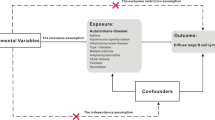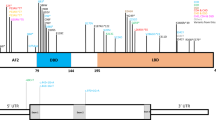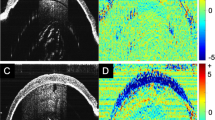Abstract
Variants in EFEMP1, encoding Fibulin-3, were previously reported as a rare cause of heritable connective tissue disorder (HCTD) with recurrent hernias and joint hypermobility. We report three new cases with biallelic or monoallelic EFEMP1 variants and severe hernia phenotypes. Two male siblings of 10 and 13 years old presented with marfanoid habitus, recurrent inguinal and umbilical hernias, generalized joint hypermobility, and scoliosis. Parents and halfsiblings reported joint hypermobility and umbilical hernias. The eldest boy died at age 16 from incarcerated gastrointestinal herniation complicated by gastric and bowel necrosis with perforation. Autopsy revealed widespread intestinal diverticula. Immunohistochemistry of skin and fascia tissue did not reveal any abnormalities, including normal staining of elastic fibers. Both siblings harbored compound heterozygous likely pathogenic EFEMP1 variants (c.1320 + 2T > A, p.? and c.698G > A, p.Gly233Asp). An unrelated 58-year-old male had marfanoid features, high myopia, recurrent diaphragmatic and inguinal hernias, and chronic gastrointestinal dilatation with severe malabsorption. Both his dizygotic twin-brother and mother had recurrent hernias and high myopia. This man died at 59 years of age, and autopsy showed extensive diaphragmatic herniation, bowel diverticula, and pulmonary emphysema. A heterozygous EFEMP1 splice-variant (c.81 + 1G > A, p.?) was identified, causing exon skipping leading to a start-loss. Targeted genome reanalysis nor RNA-sequencing revealed a second variant at the other allele. The reported individuals expand the clinical and pathological phenotypes of EFEMP1-related disease, a distinct entity within the spectrum of HCTD. The severe and recurrent hernias, gastrointestinal dilatation, and diverticulosis result in an increased risk for life-threatening complications, demanding early recognition and close monitoring.
This is a preview of subscription content, access via your institution
Access options
Subscribe to this journal
Receive 12 print issues and online access
$259.00 per year
only $21.58 per issue
Buy this article
- Purchase on SpringerLink
- Instant access to full article PDF
Prices may be subject to local taxes which are calculated during checkout


Similar content being viewed by others
Data availability
All data relevant to this study can be found within the manuscript. Additional data are available from the corresponding author on reasonable request.
References
Nezwek TA, Varacallo M. Physiology, connective tissue. Treasure Island (FL): StatPearls Publishing; 2002. https://www.ncbi.nlm.nih.gov/books/NBK542226/.
Bateman JF, Boot-Handford RP, Lamandé SR. Genetic diseases of connective tissues: cellular and extracellular effects of ECM mutations. Nat Rev Genet. 2009;10:173–83.
Pope MK, Ratajska A, Johnsen H, Rypdal KB, Sejersted Y, Paus B. Diagnostics of hereditary connective tissue disorders by genetic next-generation sequencing. Genet Test Mol Biomark. 2019;23:783–90.
Steinle J, Hossain WA, Veatch OJ, Strom SP, Butler MG. Next-generation sequencing and analysis of consecutive patients referred for connective tissue disorders. Am J Med Genet A. 2022;188:3016–23.
Milewicz DM, Braverman AC, De Backer J, Morris SA, Boileau C, Maumenee IH, et al. Marfan syndrome. Nat Rev Dis Prim. 2021;7:64.
Malfait F, Castori M, Francomano CA, Giunta C, Kosho T, Byers PH. The Ehlers-Danlos syndromes. Nat Rev Dis Prim. 2020;6:64.
Argraves WS, Dickerson K, Burgess WH, Ruoslahti E. Fibulin, a novel protein that interacts with the fibronectin receptor beta subunit cytoplasmic domain. Cell. 1989;58:623–9.
de Vega S, Iwamoto T, Yamada Y. Fibulins: multiple roles in matrix structures and tissue functions. Cell Mol Life Sci. 2009;66:1890–902.
Debeer P, Schoenmakers EF, Twal WO, Argraves WS, De Smet L, Fryns JP, et al. The fibulin-1 gene (FBLN1) is disrupted in at (12; 22) associated with a complex type of synpolydactyly. J Med Genet. 2002;39:98–104.
Bohlega S, Al-Ajlan H, Al-Saif A. Mutation of fibulin-1 causes a novel syndrome involving the central nervous system and connective tissues. Eur J Hum Genet. 2014;22:640–3.
Loeys B, Van Maldergem L, Mortier G, Coucke P, Gerniers S, Naeyaert JM, et al. Homozygosity for a missense mutation in fibulin-5 (FBLN5) results in a severe form of cutis laxa. Hum Mol Genet. 2002;11:2113–8.
Hucthagowder V, Sausgruber N, Kim KH, Angle B, Marmorstein LY, Urban Z. Fibulin-4: a novel gene for an autosomal recessive cutis laxa syndrome. Am J Hum Genet. 2006;78:1075–80.
Stone EM, Braun TA, Russell SR, Kuehn MH, Lotery AJ, Moore PA, et al. Missense variations in the fibulin 5 gene and age-related macular degeneration. N Engl J Med. 2004;351:346–53.
Kobayashi N, Kostka G, Garbe JH, Keene DR, Bächinger HP, Hanisch FG, et al. A comparative analysis of the fibulin protein family. biochemical characterization, binding interactions, and tissue localization. J Biol Chem. 2007;282:11805–16.
Stone EM, Lotery AJ, Munier FL, Héon E, Piguet B, Guymer RH, et al. A single EFEMP1 mutation associated with both Malattia Leventinese and Doyne honeycomb retinal dystrophy. Nat Genet. 1999;22:199–202.
Fu L, Garland D, Yang Z, Shukla D, Rajendran A, Pearson E, et al. The R345W mutation in EFEMP1 is pathogenic and causes AMD-like deposits in mice. Hum Mol Genet. 2007;16:2411–22.
Mégarbané A, Hanna N, Chouery E, Jalkh N, Mehawej C, Boileau C. Marfanoid habitus, inguinal hernia, advanced bone age, and distinctive facial features: a new collagenopathy? Am J Med Genet A. 2012;158A:1185–9.
Bizzari S, El-Bazzal L, Nair P, Younan A, Stora S, Mehawej C, et al. Recessive marfanoid syndrome with herniation associated with a homozygous mutation in Fibulin-3. Eur J Med Genet. 2020;63:103869.
Driver SGW, Jackson MR, Richter K, Tomlinson P, Brockway B, Halliday BJ, et al. Biallelic variants in EFEMP1 in a man with a pronounced connective tissue phenotype. Eur J Hum Genet. 2020;28:445–52.
Verlee M, Beyens A, Gezdirici A, Gulec EY, Pottie L, De Feyter S, et al. Loss-of-function variants in EFEMP1 cause a recognizable connective tissue disorder characterized by cutis laxa and multiple herniations. Genes. 2021;12:510.
Forghani I, Lang SH, Rodier MJ, Bivona SA, Undiagnosed Diseases N, Morales AA, et al. EFEMP1 haploinsufficiency causes a Marfan-like hereditary connective tissue disorder. Am J Med Genet A. 2024;194:e63556.
Li H, Durbin R. Fast and accurate short read alignment with Burrows–Wheeler transform. Bioinformatics. 2009;25:1754–60.
McKenna A, Hanna M, Banks E, Sivachenko A, Cibulskis K, Kernytsky A, et al. The Genome Analysis Toolkit: a MapReduce framework for analyzing next-generation DNA sequencing data. Genome Res. 2010;20:1297–303.
Richards S, Aziz N, Bale S, Bick D, Das S, Gastier-Foster J, et al. Standards and guidelines for the interpretation of sequence variants: a joint consensus recommendation of the American College of Medical Genetics and Genomics and the Association for Molecular Pathology. Genet Med. 2015;17:405–24.
Biesecker LG, Byrne AB, Harrison SM, Pesaran T, Schäffer AA, Shirts BH, et al. ClinGen guidance for use of the PP1/BS4 co-segregation and PP4 phenotype specificity criteria for sequence variant pathogenicity classification. Am J Hum Genet. 2024;111:24–38.
Dekker J, Schot R, Bongaerts M, de Valk WG, van Veghel-Plandsoen MM, Monfils K, et al. Web-accessible application for identifying pathogenic transcripts with RNA-seq: increased sensitivity in diagnosis of neurodevelopmental disorders. Am J Hum Genet. 2023;110:251–72.
Franssen S, Beek MA, Lagarde SM. [A cachectic man with a severe vitamin deficiency]. Ned Tijdschr Voor Geneeskd. 2021;165:D5491.
Livingstone I, Uversky VN, Furniss D, Wiberg A. The Pathophysiological Significance of Fibulin-3. Biomolecules, 2020;10:1294.
Woodard DR, Daniel S, Nakahara E, Abbas A, DiCesare SM, Collier GE, et al. A loss-of-function cysteine mutant in fibulin-3 (EFEMP1) forms aberrant extracellular disulfide-linked homodimers and alters extracellular matrix composition. Hum Mutat. 2022;43:1945–55.
McLaughlin PJ, Bakall B, Choi J, Liu Z, Sasaki T, Davis EC, et al. Lack of fibulin-3 causes early aging and herniation, but not macular degeneration in mice. Hum Mol Genet. 2007;16:3059–70.
Gómez AE, Alvarado K, Yase RA, Hsu Y-H, Hulleman JD, Kwon RY. Dominant nonsense mutations in efemp1 alter vertebral and craniofacial characteristics in adult zebrafish. bioRxiv, 2024: p. 2024.02.16.580611.
Giltay R, Timpl R, Kostka G. Sequence, recombinant expression and tissue localization of two novel extracellular matrix proteins, fibulin-3 and fibulin-4. Matrix Biol. 1999;18:469–80.
Ellinghaus E, Ellinghaus D, Krusche P, Greiner A, Schreiber C, Nikolaus S, et al. Genome-wide association analysis for chronic venous disease identifies EFEMP1 and KCNH8 as susceptibility loci. Sci Rep. 2017;7:45652.
Ahmed WU, Kleeman S, Ng M, Wang W, Auton A, Research T, et al. Genome-wide association analysis and replication in 810,625 individuals with varicose veins. Nat Commun. 2022;13:3065.
Callewaert B, Su CT, Van Damme T, Vlummens P, Malfait F, Vanakker O, et al. Comprehensive clinical and molecular analysis of 12 families with type 1 recessive cutis laxa. Hum Mutat. 2013;34:111–21.
Ahmed WU, Patel M, Ng M, McVeigh J, Zondervan K, Wiberg A, et al. Shared genetic architecture of hernias: A genome-wide association study with multivariable meta-analysis of multiple hernia phenotypes. PLoS ONE. 2022;17:e0272261.
Ehlermann J, Weber S, Pfisterer P, Schorle H. Cloning, expression and characterization of the murine Efemp1, a gene mutated in Doyne-Honeycomb retinal dystrophy. Gene Expr Patterns. 2003;3:441–7.
Funding
No funding was received.
Author information
Authors and Affiliations
Contributions
VV and SD: clinical data collection, conceptualization, supervision. MM: clinical data analyses, data presentation, original draft preparation. TH, HB, and LU: genetic data collection and analyses, data visualization. JK and RV: pathological data collection and analyses. NB, JE, JR, and JV: clinical data collection. All authors read, reviewed, and edited the final manuscript.
Corresponding author
Ethics declarations
Competing interests
The authors declare no competing interests.
Ethical approval and consent to participate
All subjects or legal guardians provided written informed consent for publication of this manuscript. Specific informed consent was obtained for the publication of clinical pictures. Standard postmortem investigation was performed upon consent by the relatives of the deceased. The study was conducted in accordance with the 1984 Declaration of Helsinki and its subsequent revisions.
Additional information
Publisher’s note Springer Nature remains neutral with regard to jurisdictional claims in published maps and institutional affiliations.
Rights and permissions
Springer Nature or its licensor (e.g. a society or other partner) holds exclusive rights to this article under a publishing agreement with the author(s) or other rightsholder(s); author self-archiving of the accepted manuscript version of this article is solely governed by the terms of such publishing agreement and applicable law.
About this article
Cite this article
Mol, M.O., van Ham, T.J., Bannink, N. et al. Biallelic and monoallelic variants in EFEMP1 can cause a severe and distinct subtype of heritable connective tissue disorder. Eur J Hum Genet 32, 1567–1573 (2024). https://doi.org/10.1038/s41431-024-01692-x
Received:
Revised:
Accepted:
Published:
Issue date:
DOI: https://doi.org/10.1038/s41431-024-01692-x
This article is cited by
-
New guidelines for rare cancer syndromes
European Journal of Human Genetics (2024)



